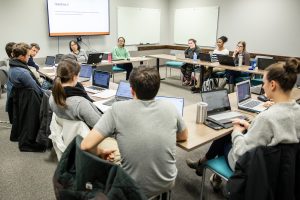After an extensive pilot, Fall 2022 marked the first semester when instructors could choose to teach using Canvas. ITS Educational Technologies (EdTech), which manages both systems, has set a date to sunset, or retire, Sakai.
At a glance
- 40% of all courses at UNC-Chapel Hill are using Canvas
- Spring 2024 will be the last semester instructors can teach using Sakai
- Sakai courses will be available in read-only mode through Spring 2026
Canvas use grows
“We have 40% of courses using Canvas this Spring 2023 term,” said Thao Nghi Tu, learning technologies administrator with EdTech. That’s 1,402 courses, 1,543 instructors and 20,589 students using Canvas this semester. “I’m pretty happy about this number and look forward to seeing how many more courses will be taught in Canvas in Fall 2023,” Tu said.
Although Fall 2022 was the first semester any instructors could teach in Canvas, uptake was swift, with 20% of courses taught in Canvas. EdTech viewed the 20% growth between Fall and Spring semesters as a win, especially because of the semester structure. Because of the short break between semesters, many instructors weren’t quite ready to make the switch.
“I’m sure more instructors were thinking of teaching in Canvas, but I imagine a lot of them will just wait until the Fall semester since they will have the summer months to work on adapting their courses to the new system,” Tu said.
Sunset for Sakai

Sakai users will need to keep an eye on the horizon. Spring 2024 will be the last semester Sakai can be used for teaching, or any other use.
When Spring 2024 ends, EdTech will transition Sakai to read-only. In read-only mode, instructors can still view their content as they build out their courses in Canvas, but they cannot make changes to the Sakai site itself.
Sakai will remain in read-only mode through Spring 2026. In Summer 2026, EdTech will completely decommission Sakai, and it will be unavailable for any purpose.
Suzanne Cadwell, director of EdTech, emphasized that Sakai-to-Canvas timeline decisions were made in consultation with the UNC-Chapel Hill community. The Faculty Information Technology Advisory Committee (FITAC) discussed the timeline at its October 2022 meeting. Specifically, Cadwell said the committee discussed faculty and staff members’ desire to have more time to transition to Canvas and leave Sakai in an archival state for reference. FITAC endorsed the final timeline in November. The provost announced the timeline to the Faculty Council at its December meeting.
Long transition gives instructors options
The long transition ensures instructors have time and support to switch from Sakai to Canvas.
“The difficulty of transitioning to Canvas is relative,” said Marla Sullivan, EdTech tech support specialist and project manager for the Canvas rollout. The difficulty, she said, depends on many factors, such as course complexity, tool usage and how comfortable the instructor is with the technology.
Switching to Canvas means two main choices for instructors — start from scratch or modify an existing course that’s been migrated from Sakai. Before the start of each semester, EdTech works with a vendor to copy and migrate Sakai courses to Canvas. For Spring 2023, EdTech migrated and converted 3,200 courses taught in Sakai in Spring 2022.
Course migration has been a challenge for EdTech. “Although Sakai and Canvas offer similar features, their underlying data structures are vastly different,” Cadwell said. The difference makes “clean and complete data transfers between two systems highly challenging.”
One of those challenges is that sometimes course imports will time out repeatedly, especially with courses that have large amounts of data in resources or Sakai tests and quizzes. In some situations, EdTech has been able to assist, but in others faculty members have needed to reduce the complexity of their site structure or move content in batches rather than all at once, Cadwell said.
Supporting the transition

“Regardless of whether faculty members choose to build from scratch in Canvas or reuse migrated Sakai content, everyone will want to spend some time on Canvas training and course development,” Sullivan said.
While the copied courses are a good starting place, Tu and Sullivan strongly encourage instructors to review the all-in-one resource, Getting Course Content into Canvas. One of the issues that comes with migration is cleanup. The amount of cleanup “varies between sites,” Tu said, but some courses may require a lot of tweaking before the course is ready in Canvas. She recommends that instructors check out the list of common issues.
“While Instructure [the maker of Canvas] has a lot of really great help guides and training videos, we know this is a significant change to our faculty, so we wanted to take a more personalized approach to help them feel more comfortable with the new system,” Tu said.
Because instructors were already familiar with Sakai, the EdTech team created Moving from Sakai to Canvas, which helps to address the question of “I do this [action] in Sakai. How do I do it in Canvas?” The training materials, which include a set of nine training videos, feature crosswalks between the two systems and their comparable tools and general resources to help users build their courses.
While EdTech finds that most users prefer to use the videos and learning guides to watch and learn on their own, “we also wanted to provide ample opportunity to attend live training and answer any questions instructors may have,” Tu said. EdTech, she said, will continue to offer live trainings as instructors prepare courses for upcoming semesters.
24/7 support
Webpages, recorded videos and live workshops aren’t the only way instructors can get help with Canvas. There’s also 24/7 live support for all users. Instructure provides first-level support by chat or by phone 24 hours a day, 365 days a year. This is a huge perk to instructors who may have questions at night or on weekends when EdTech staffers aren’t available.
Having Canvas experts available 24/7 has been “invaluable” to the transition, Tu said. Not only do users get answers to questions any hour of the day or night, but it relieves some pressure on the small EdTech support team. “We’re able to address questions specific to our UNC instance in a timely manner and focus more efforts on the transition as a whole,” she said.
A great upcoming opportunity to learn more about Canvas is the two-day CFE Faculty Showcase on Teaching, slated for March 23 and 24. Co-sponsored by the Center for Faculty Excellence, ITS Educational Technologies and the Office of Arts and Sciences Information Services, the Faculty Showcase gives instructors from all over campus an opportunity to connect with and learn from their peers. Register by March 22.
Sessions range from topics like AI to grading and include Canvas. At the “Canvas is a Teaching Toolkit” session, eight instructors will discuss the tools and teaching methods they use in the Canvas system.
Getting ready for what’s next
Now that the Spring semester is halfway over, it’s time to start thinking about Summer and Fall courses.
Summer 2023 course sites are now available to instructors teaching in Maymester, Summer Session I and Summer Session II. Fall 2023 course sites will be available in Canvas in late May.
Copied course content from Registrar courses that were taught in Sakai in Summer and Fall 2022 is also now available. Instructors will find archive sites on their Canvas dashboards with their migrated content, titled “DEPT101.001.S122_k16_SAKAI_Archive.”
For upcoming training opportunities, check EdTech’s Canvas site or the announcements section of Canvas. In April, expect end-of-semester resources and live training to help instructors start using Canvas. Summer course planning resources arrive in early May.
Popular and familiar

Canvas is popular with instructors and students alike, and part of that popularity comes from familiarity. Instructure, the maker of Canvas, states that “the world is adopting Canvas faster than any other LMS,” and as far back as 2018 Canvas took over the lead spot for the most-used LMS in higher ed. As a result, instructors who come to UNC-Chapel Hill from other institutions may already have some experience with Canvas.
Canvas is common in K-12 settings, so many students may have already used it. “This familiarity may help ease the transition to college courses while learning a new LMS like Sakai would be an added challenge,” Sullivan said.
During the pilot phase of the Canvas rollout, EdTech staff members met with participants to gather feedback on their experience with using Canvas. Data from the pilot phase suggested that students who had prior experience with Canvas preferred it to Sakai.
“With each incoming class, the percentage of the student body with Canvas experience will continue to increase while the percentage with Sakai experience decreases,” Sullivan said.
Putting feedback to use
EdTech also gathered feedback from instructors during the pilot phase and used it to improve the experience of creating Canvas courses. Initially, EdTech provided a course template created by an instructional designer from Instructure. After feedback from the pilot group, EdTech created a simpler version of the template that instructors could copy into their courses from the Canvas Commons. The Canvas Commons, which has thousands of shared items, is a place for any Canvas educator to share and copy instructional resources and Canvas items.
“A template not only provides instructors with a starting point for building out their course content, but it gives students a similar learning experience across their courses,” Tu said. Templates can also be applied at a school or departmental level in Canvas, enabling units to decide if they’d like a common template across all their courses.
EdTech partnered with the School of Nursing and the Digital Accessibility Office to create the simplified template, ensuring that it met digital accessibility standards.
Apps add value

EdTech continues to improve the Canvas experience by adding features that were not available in Sakai. One of these areas where Canvas adds value is the Edu App Center. Like the Canvas Commons, which houses shared instructional resources and Canvas items, the Edu App Center is a centralized place to find learning tools and integrations.
“Teaching online is more than just sharing files and taking tests. You want to create different pathways, to learn and also engage students,” said Morgon Haskell, instructional technology support specialist with EdTech. The Edu App Center lets instructors “shop around” for different tools within a marketplace of apps. “It gives people a way to evaluate, read reviews, see what their services are about,” he added.
While instructors can choose to enable individual apps that were already curated and approved by EdTech, EdTech can also enable apps for everyone using Canvas at Carolina. Earlier this semester, EdTech enabled a Zoom Pro integration into Canvas courses. The plugin lets instructors schedule meetings through their courses in Canvas, so they don’t have to create their meetings in Zoom and copy links. Even better, Tu said, “if they’re recording those sessions, they’ll automatically get populated into the Panopto video streaming tool.”
EdTech, in collaboration with other ITS units, is revamping the process to integrate new learning applications in Canvas. The teams are working through the risk assessment and approval process for learning apps provided by publishers such as Pearson, Cengage and Macmillan to make Canvas a one-stop shop for online learning.
